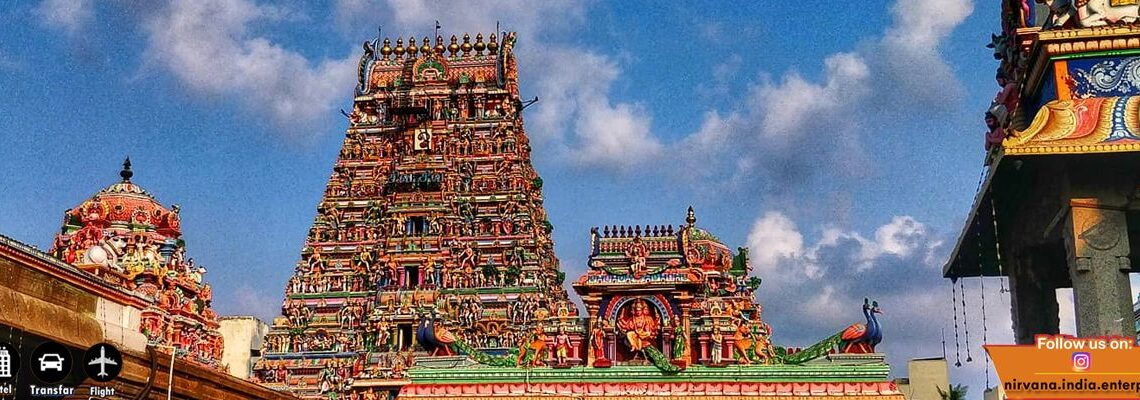The Kapaleeshwarar Temple sits tucked away in Mylapore, one of Chennai’s oldest corners in Tamil Nadu, a place where the city’s rush seems to fade into a hum of prayers and devotion. The temple is dedicated to Lord Shiva, and also called Kapaleeshwarar, with his consort Parvati, known as Karpagambal, watching over the devotees. The temple’s massive gopurams rise like pillars against the sky, and its courtyards give the final touch and one just to stands in awe of its beauty. It’s not just stone and carvings; it’s a living piece of Chennai, carrying centuries of faith and tales.
Legend of the Temple
The legend says that long ago, Parvati asked Shiva to share the universe’s deepest truths. He started explaining, but her eyes wandered to a peacock strutting by, catching her focus. Shiva, not one for distractions, cursed her to become a peacock herself, saying she’d have to worship him in that form to earn back her place. So, Parvati, now a bird, landed in Mylapore and made a lingam out of the sand by the shore. She worshipped the linga with intense devotion, day after day, until Shiva, softened by her devotion, lifted the curse and brought her back to her divine self. That sand lingam became the temple’s heart, named Kapaleeshwarar, tied to “kapalam,” meaning skull, from a story where Shiva wears skulls as a garland. Parvati’s shrine as Karpagambal, the mother who grants wishes, stands close, and you can see peacocks carved in the stone as one of her incarnations.
History of Kapaleeshwarar Temple
The temple’s story goes way back to the 7th century, as per the old Tamil hymns. Saints like Sambandar and Appar sang about a Shiva shrine in Mylapore in their Tevaram, which is said to be the temple area of today. However, the temple we walk through today isn’t that ancient. The Portuguese, pushing their way into Chennai in the 1500s, destroyed the original structure, which sat closer to the sea. What we can see in the present was raised in the 1600s by the Vijayanagara kings, who wanted to bring it back to life. Before the Vijayanagaras, the Pallavas, ruling up to the 9th century, land the Cholas, big Shiva devotees, probably added their own touches, but it’s the Vijayanagara rulers who really built it up. They built up the gopurams and gathering halls, carving their gifts—land, gold, oil for lamps—into the stone. The temple’s spiritual roots run deep. Those Tevaram hymns make it a Paadal Petra Sthalam, a sacred Shiva site, and saints like Arunagirinathar, who sang to Murugan here, wove it into Tamil faith. It’s been a beacon for Chennai’s Saiva community, standing strong through centuries of change.
Architecture of the Temple
Walking into the Kapaleeshwarar Temple is like stepping into a world where every stone is alive with the presence of Shiva. It’s Dravidian style, with two gopurams—one east, one west—bursting with color and carvings show the Tamil heritage. The eastern gopuram, stretching up about 120 feet, hits you hard, covered in devas, rakshasas, and divine dancers. The western one’s a bit smaller but just as rich, leading you into a courtyard that feels alive.
At the heart is Kapaleeshwarar’s lingam, said to be self-born, sitting in a shrine heavy with reverence. Karpagambal’s shrine, close by, has a motherly presence, like she’s watching over everyone. There’s also a tank, the Kapaleeshwarar Teppakulam, where festival idols float on rafts, and a hall with 63 bronze statues of Saiva saints, tying it to Tamil devotion. The pillars are carved with scenes like Shiva’s dance or Parvati as a peacock. A Punnai tree in the courtyard, tied to local myths, and small shrines their children, Ganesha and Murugan are worshipped by the devotees.
Festivals
As a Paadal Petra Sthalam, it is one of the most celebrated temple complex. Festivals like Arubathimoovar in March, a 10-day celebration of the 63 Saiva saints, fills Mylapore’s streets with processions and songs. Panguni Peruvizha, marking Shiva and Parvati’s wedding, is all devotion and color, with rituals that pull everyone in. Six daily poojas, from dawn to night, keep the temple’s divine presence alive and blazing.
Cultural and Modern Importance
This temple’s more than a place to pray—it’s a piece of Chennai’s soul. Festivals here spark Carnatic music and Bharatanatyam dances, keeping Tamil arts alive. It’s shaped the city’s poets and singers for centuries, feeding into Mylapore’s creative pulse. The neighborhood, one of Chennai’s oldest, leans on the temple like a friend, its streets buzzing with its influence.
Just 7 km from Chennai’s main station, it’s easy to reach by auto or bus, sitting in a city that’s modern but holds its history close. The temple’s a bridge between those worlds, a spot where kids hear old stories and elders pass on songs. The Punnai tree, tied to Parvati’s tale, and the peacock carvings keep the legend close, while the temple’s role in Saiva faith shapes how people here live and think.
Conclusion
The Kapaleeshwarar Temple isn’t just a landmark but is one of the living Temple Kshetra of Shaiva tradition. Its legend of Parvati’s devotion, its rise from ruins, its carved beauty, and its deep Saiva roots make this temple a living reality and is a must visit.











